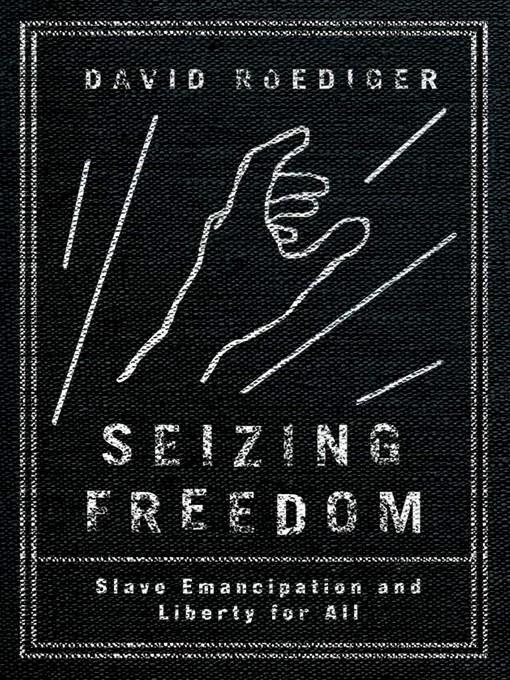
Seizing Freedom
Slave Emancipation and Liberty for All
- اطلاعات
- نقد و بررسی
- دیدگاه کاربران
نقد و بررسی

September 29, 2014
Nearly 80 years ago, W.E.B. Du Bois described the “general strike of slaves” during the Civil War, in which the unfree laborers either ran away from their masters’ plantations or stayed on only to slow down and sabotage the work. Most slaves didn’t wait for someone to free them, they took advantage of the war’s many disruptions and freed themselves. Historian Roediger (How Race Survived U.S. History) takes this as his focal point, offering up a counterbalance to recent historical works—and a big-budget Hollywood movie as well—that have de-emphasized slaves’ agency to highlight the roles of prominent whites in the emancipation of slaves. His first chapter centers on the pursuit of Jubilee, the biblical concept of a “cyclical time of liberation, of abolition, and of mechanisms of redress that specifically included land redistribution.” Roediger expands his scope to investigate how slaves also created the meaning of freedom, and the following three chapters examine a “fascinating brew of issues” associated with the general strike and self-emancipation, ranging from whiteness and disability to working-class agitation for the eight-hour day and women’s suffrage. It’s a brief and stimulating work, but equally dense, and though Roediger’s intellectual reach is expansive, it will likely prove difficult for lay readers. Illus.

October 15, 2014
Historian Roediger (American Studies and History/Kansas Univ.; Race Survived U.S. History: From Settlement and Slavery to the Obama Phenomenon, 2008, etc.) examines the self-emancipation of slaves during the Civil War as the galvanizing force behind the movements for women's suffrage and labor improvement.The author works from the premise that while President Abraham Lincoln vacillated over the Emancipation Proclamation, the slaves were already emancipating themselves in a massive display of biblical "Jubilee." Fleeing to the woods, depriving the Southern plantations of their labor, and joining and aiding Union lines all created what W.E.B. Du Bois called a "general strike of the slaves." Roediger shows how this massive self-emancipation from below set in motion "radiating impulses toward freedom," promoting literacy for freedmen, a pursuit of family ties and a new sense of social motion. For black women, this meant a "control over time," in the ability to choose their own work, while the idea of women's suffrage could finally overcome its sense of sheer impossibility. Eventually, such leaders as Elizabeth Cady Stanton and Lucretia Mott formed important bonds with abolitionist leaders like Frederick Douglass. Moreover, women during the Civil War did much of the work caring for the sick and wounded, keeping the households running, raising children amid chaos and doing mostly unpaid civic duty: "Women's suffrage consciously appealed to this heroism in arguing that voting rights were owed women." The labor movement's drive for an eight-hour-day gained momentum, and Irish nationalism helped opened new space for ethnic solidarity. In a particularly fascinating chapter, Roediger looks at how the period of Reconstruction also offered an "emancipation from whiteness." Wounded soldiers returning from war were perceived as "disabled," just as blacks and women had once been regarded as "unfit" for freedom. By 1869, however, the revolutionary coalitions began to break apart, Reconstruction was betrayed, and terror swept the South. Slenderly packed scholarship conveying provocative ideas.
COPYRIGHT(2014) Kirkus Reviews, ALL RIGHTS RESERVED.

December 1, 2014
Historian Roediger identifies connections between the self-emancipation of slaves during the Civil War and other transformative social movements of the day, including women's suffrage, labor reform, and the disability-rights movement. The Jubilee of newly freed slaves, he suggests, inspired glimmers of solidarity among former slaves, Northern wage workers seeking an eight-hour workday, and feminists; it also opened a space in Reconstruction-era society for new emancipation movements seeking rights for wounded soldiers, immigrants, and others. The key to these linked movements was imagination of what might be possible, as freed slaves performed freedom, and the previously unimaginable emancipation of former slaves continued to capture popular imagination. It was, Roediger suggests, a revolutionary time. And though this period would soon end, as movements evolved and ceased to be aligned, Roediger suggests that we might learn from this period as we observe similar moments of convergence rise and fall. Though decidedly scholarly in its tone and its careful positioning of its assertions, this selection dovetails nicely with Douglas Egerton's The Wars of Reconstruction (2014) and other recent attention to this important era.(Reprinted with permission of Booklist, copyright 2014, American Library Association.)




دیدگاه کاربران